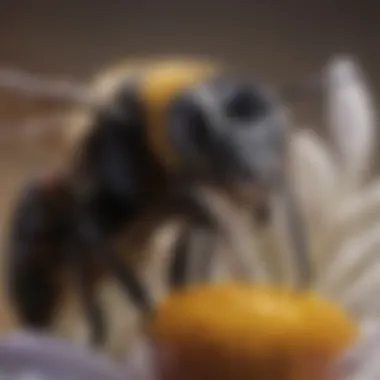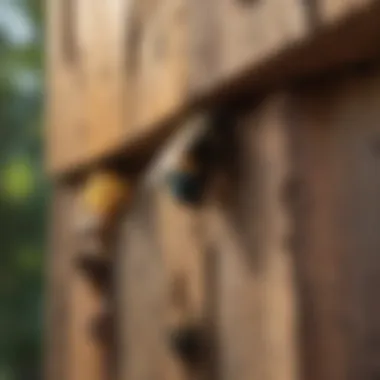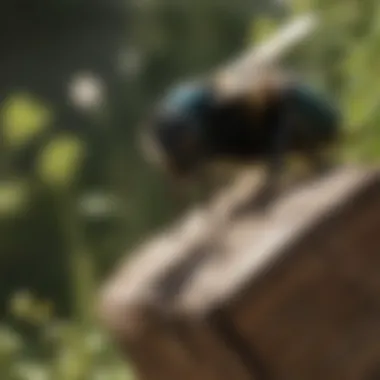Navigating the Challenges of Carpenter Bees


Intro
Carpenter bees often spark mixed feelings among homeowners. These industrious little creatures play a vital role in pollination, bolstering our gardens and crops. However, their nesting habits can lead to havoc in our beloved wooden structures. This article seeks to provide a balanced understanding of the carpenter bee dilemma by weaving through their behavioral traits, the potential risks they pose, and practical management strategies. Potential damage they might inflict on homes makes getting acquainted with them essential.
By unraveling the complexities associated with these bees, homeowners will be better equipped to protect their properties without ignoring the ecological benefits carpenter bees provide. As we delve deeper, we will explore how to appreciate these important pollinators while mitigating threats to our woodwork.
Design Inspiration
Before kicking off into the brass tacks of management strategies, let’s first explore the design aspects related to addressing carpenter bees. While it might seem far-fetched, the aesthetic angle can influence how we approach their nesting habits.
Trending Styles
In considering styles for your outdoor space, a rustic yet modern design could be appealing. Utilizing materials like cedar or redwood can act as a natural deterrent due to their resistant properties. It’s not just about aesthetics; it’s a strategic choice, marrying functionality with style.
Adding decorative wooden features can also draw attention away from areas that are prone to bee activity. Trellises adorned with climbing plants, for instance, attract bees away from your foyer or porch while enhancing your outdoor environment.
Color Palettes
Color selection is another component that affects bee behavior. Bees are drawn to bright colors like yellow and blue. When choosing paint or materials for your outdoor furniture, consider more muted tones that blend with nature. Earthy greens and browns can help in downplaying the attraction without sacrificing the overall charm of your space.
"By consciously selecting your materials and colors, you can create a balance between allure and aversion, making outdoor spaces more harmonious with nature while protecting your home."
Practical Tips
Finding the balance between enjoying your yard and keeping carpenter bees at bay necessitates some strategic planning.
Maintenance & Care
Regular maintenance of your wooden structures is crucial. Inspect your home’s exterior for any signs of damage that could invite carpenter bees. Filling cracks or repainting weathered sections can be your first line of defense. Here are some practical things to consider:
- Use paint or sealants that are bee-repellent
- Opt for hardwoods that are less attractive to nesting
- Perform seasonal checks to catch issues early
Budgeting & Planning
Understanding the cost associated with pest management will help you allocate your resources wisely. It might seem easier to ignore the signs at first, but ignoring carpenter bees can lead to larger expenses down the road. Factor in potential costs like:
- Repair work on damaged wood and structures
- Preventive materials, like specific paints and finishes
- Professional services for removal if the situation escalates
Planning budgetary measures in advance can save you from a financial headache later on. Preparing for these little nuisances can help preserve both your home and your peace of mind.
Prologue to Carpenter Bees
Understanding carpenter bees is essential for homeowners and gardening enthusiasts alike. These creatures are more than just a nuisance; they play a significant role in our ecosystems. Though they possess a reputation for damaging wooden structures, their contributions to pollination cannot be overlooked. In this section, we will explore the dual nature of carpenter bees, highlighting both their ecological benefits and the concerns they present for property owners. This balanced view is crucial because it arms homeowners with the knowledge needed to appreciate these bees while taking necessary precautions against potential damage.
Defining Carpenter Bees
Carpenter bees, belonging to the genus Xylocopa, are medium-to-large-sized insects resembling bumblebees. One notable characteristic that sets them apart is their shiny, hairless abdomen compared to the fuzzy appearance of bumblebees. Typically, they range from about half an inch to slightly more than an inch in length. Most carpenter bee species are solitary; only the females construct nests, which they do by boring into wood.


These nests are often made in untreated wood, a fact that poses a challenge for homeowners. The female carpenter bee creates a series of tunnels where her offspring will eventually develop, making them both intriguing and troublesome. For homeowners, encountering these bees can raise questions about safety and property maintenance, as these tunnels can lead to structural damage if left unchecked.
Ecological Role of Carpenter Bees
Carpenter bees contribute significantly to pollination, particularly for flowering plants native to their regions. They have a unique method of pollination called "buzz pollination," which involves vibrating their bodies to release pollen from flowers. This method is especially beneficial for plants like tomatoes and blueberries that require more vigorous pollination methods. The ecological ramifications of their actions stretch far, as these bees contribute not just to home gardens but also to the health of entire ecosystems.
"The role of carpenter bees in pollination cannot be overstated; they are paramount for many plants' reproductive success."
In addition to their role as pollinators, carpenter bees serve as food for various predators, including birds and mammals. This interconnectivity emphasizes the importance of their presence in maintaining ecological balance. Thus, while they may cause an eye twitch for those invested in home aesthetics, recognizing their vital ecological role is imperative.
In summary, understanding carpenter bees encompasses a broader perspective. By exploring their definitions and ecological roles, we pave the way for deeper insight into the subsequent sections related to their identification, nesting behaviors, impacts on homes, and effective management strategies. In doing so, homeowners can adopt a holistic approach to handle their presence—balancing the benefits of these buzzing creatures with the reality of structural concerns.
Identifying Carpenter Bees
Understanding the nuances of identifying carpenter bees is crucial for homeowners. Recognizing these insects not only aids in ensuring the integrity of your home but also helps in appreciating their ecological role. It’s vital to discern carpenter bees from other types of bees, as their nesting habits and behaviors can significantly impact wooden structures. With clarity on their identification, one can forge a real strategy to address any potential issues.
Physical Characteristics
Carpenter bees are rather distinct in appearance. They bear a striking resemblance to bumblebees but serve as unique individuals in the insect world. A common physical feature is their robust bodies; adult male carpenter bees can range from about 0.5 to 1 inch in length. Their color varies between species, sometimes displaying a shiny, hairless abdomen, which is quite different from the fuzzy bumblebee appearance. Here are some notable characteristics:
- Color: Most carpenter bees sport a black or brown body, which may have yellow markings, providing a stark contrast to their bare abdomen.
- Body Shape: Their bodies are more elongated compared to bumblebees, giving them a slightly more streamlined appearance.
- Sex Differences: The male carpenter bees lack a stinger, being more interested in defending their territory than harming humans. Females, on the other hand, can sting but are typically docile if left undisturbed.
Knowing these characteristics can equip homeowners with the knowledge necessary to identify these bees correctly, allowing for informed decisions about their presence. Being able to recognize a carpenter bee can also avert unnecessary panic, should one encounter them around the home.
Behavioral Traits
Carpenter bees exhibit fascinating and, at times, perplexing behaviors. Observing these traits can shed light on their lifecycle and nesting preferences, vital for anyone wanting to mitigate potential damage. Notably, male carpenter bees are often seen engaging in territorial displays, charging at anything that enters their perceived domain. This behavior can be alarming to those unprepared but does not usually lead to aggression.
Furthermore, carpenter bees are solitary and prefer to nest in old, weathered wood. They are known to drill round holes, around half an inch in diameter, into wooden structures, which can lead to potential structural damage over time. Their preferred habitats often include:
- Wooden Roofs: Many will select eaves and beams as their nesting sites.
- Decks: Older wooden decks are also a hot spot for these bees, particularly if they are untreated.
- Fences and Sheds: These structures can provide both nesting opportunities and shelter from harsh conditions.
It’s worth noting that while carpenter bees are often mistaken for pests, they play an essential role in pollination, contributing to garden health.
In summary, understanding both the physical and behavioral traits of carpenter bees allows for better management techniques. Their distinct characteristics and nesting habits present direct implications for homes, marking the necessity for awareness and informed strategies among homeowners.
Nesting Habits
Understanding the nesting habits of carpenter bees can shed light on their behavior and guide homeowners in effectively managing their presence. These bees are known for their unique choice of nesting sites, often selecting soft, untreated wood for their homes. This preference can serve as a double-edged sword; on one hand, it is essential for their lifecycle, while on the other, it raises concerns for homeowners who find their wooden structures at risk.
Preferred Habitats
Carpenter bees are particularly partial to areas that provide ample sunlight and sheltered alcoves. They often favor:
- Untreated wood: Old fences, composite wood, or wooden buildings with softwood elements are prime targets.
- Sunlit areas: The warmth of direct sunlight stimulates their activity, making areas that receive plenty of light more appealing.
- Undisturbed regions: Places that are not frequently disturbed by human activity or environmental changes allow bees to thrive without threats.
Their choice of habitat speaks volumes about their ecological preferences; they typically enjoy environments where they can easily find food sources like flowering plants. This requires a patchwork of compatible flora, fostering their role as natural pollinators while exposing downside for property owners.
Damage to Wooden Structures


The penchant for nesting in wood can lead to significant issues for structures. Carpenter bees do not eat wood, but they do burrow into it to create nesting galleries. The following points illustrate the nature of the damage:
- Hollow tunnels: These bees drill into wood, creating tunnels that can weaken the integrity of structures over time.
- Entry and exit holes: Small round holes, akin to the size of a dime, visible on exterior wood surfaces, are clear indicators of a carpenter bee infestation.
- Secondary pests: Once these bees create tunnels, they may attract other pests, compounding the damage as insects like wasps could take advantage of the space.
Ignoring the problem can escalate the damage if these bees establish a larger colony. Thus, recognizing and addressing their nesting habits early can help mitigate costlier repairs down the line.
"Understanding the nesting behaviors of carpenter bees sheds light on their ecological contributions—and leads to better property management strategies."
Proper inspection of wooden structures, especially those made from untreated wood, can reveal many signs of carpenter bee activity. Homeowners are advised to be vigilant in checking for signs of their presence during the warmer months, as these insects are most active in spring and summer.
The Impact of Carpenter Bees on Homes
Carpenter bees can stir a debate among homeowners and gardeners alike. While they are known for their important role as pollinators, their presence can also raise eyebrows due to potential damage they cause. Understanding the implications of carpenter bees on your home is crucial for making informed decisions about management and prevention strategies. The concerns stretch from structural integrity to aesthetic impacts, both of which can affect property values and comfort.
Knowing how these bees interact with your home environment provides a holistic view, merging ecological importance with practical living considerations. Hence, this section dives into the structural concerns and aesthetic factors that accompany the carpenter bee dilemma, helping you navigate this complex topic.
Structural Concerns
Carpenter bees are particularly infamous for their nesting habits, which predominantly entail boring holes into wood. These bees prefer untreated softwoods like cedar, pine, and even the thin eaves of your home. Over time, if not addressed, the damage might not just be a few holes but rather a series of tunnels that can weaken and compromise the structural integrity of your home.
- Damage Assessment: Homeowners often notice the first signs of trouble through small, round holes. But a lackadaisical approach can lead to a severe situation where extensive tunneling compromises the wood’s structural function. It's not unusual to discover that these bees have infested wood beams, door frames, or even the roof structure.
- Long-term Implications: If not managed properly, the repetitive nature of these favorable nesting sites can lead to costly repairs. Structural replacements due to rot caused by moisture retention from honeycomb left behind can make your remodeling budget take a hit.
- Prevention is Key: Regular inspections of your wooden structures, especially in certain seasons, can help identify early signs of carpenter bee activity. Consider applying protective coats to untreated woods or opting for harder woods that are less appealing to these insects.
"Ignoring the whispers of carpenter bees can often lead to loud and costly repairs."
Aesthetic Considerations
Beyond structural worries, the aesthetic aspects of having carpenter bees buzzing around areas of your home should not be overlooked. Their penchant for boring through wood can lead to unsightly marks, not to mention the visual disturbance caused by their presence.
- Visual Appeal: Holes and sawdust trailing from wooden fixtures create an unkempt look, which can be particularly bothersome for those curating well-manicured outdoor spaces or pristine entryways. Only getting rid of these intruders might not suffice; one has to think about visual restoration as well.
- Furniture Affects: In gardens or patios, untreated wooden furniture may also fall victim. Aside from the unsightly holes, the structural stability of chairs or tables could be compromised if carpenter bees choose your outdoor setup as their home.
- Community Appearance: On a broader scale, infestations can contribute to the overall community's appearance. Homes that seem neglected due to pest issues can tarnish neighborhood aesthetics and potentially affect property values.
In summary, the impact of carpenter bees on homes weaves together significant structural and aesthetic concerns. By staying vigilant and proactive, it is possible for homeowners to balance the ecological benefits of these bees with the realities of maintaining a safe and visually pleasing property. This understanding can empower communities and individuals alike, helping everyone to appreciate both nature's wonders and the sanctity of their homes.
Managing Carpenter Bees
Managing carpenter bees is crucial for homeowners who appreciate the beauty of their properties but also want to protect against potential damage. Recognizing their role in nature as pollinators should not overshadow the reality that these bees can create considerable issues for wooden structures. This section dives into effective strategies for managing their presence, understanding how to do so responsibly and humanely.
Prevention Strategies
Several measures can be taken to prevent carpenter bees from nesting around your home. It’s wise to take these steps seriously as they build their nests by boring into wood. Here are some practical strategies:
- Seal potential entry points: Carpenter bees favor untreated or weathered wood. Applying a weatherproof sealant to unpainted wood surfaces can deter them from making a home.
- Use a proper paint: Applying a good quality paint or stain can create an unattractive environment for these bees. They don’t like the smell or texture of painted surfaces.
- Opt for certain plants: Some plants like marigolds or mint can repel carpenter bees. Placing these around your home not only enhances your garden but also serves an additional function.
Taking these preventative actions doesn't just help in keeping your home safe; it reinforces the structure itself against potential damage.
Direct Control Methods
If you've already spotted carpenter bees around your home, direct control methods may be necessary. This approach involves intervention to eliminate or relocate the bees. Here are some effective methods:


- Insecticidal sprays: Applying specialized insecticides directly to the entrance of the nests can help in controlling the bee population. Make sure to wear proper protective gear during application.
- Vacuuming: A practical approach, using a vacuum cleaner with a hose attachment can remove bees while they are inactive. This method is most effective in early morning or late evening when the bees are less active.
- Professional extermination services: If the infestation is significant, sometimes it’s best to hire professionals who can safely remove the bees while minimizing risk to the environment and yourself.
While it's essential to address the issue, take care to follow local regulations regarding pest control.
Non-lethal Approaches
For those who prefer a humane approach when dealing with carpenter bees, non-lethal methods are worth considering. These strategies focus on deterring bees without exterminating them:
- Repellent sprays: Some natural repellent sprays, like those containing peppermint oil, can deter carpenter bees without harming them.
- Nesting boxes: Providing alternative nesting areas can redirect the bees away from your wooden structures. Creating bee hotels with untreated wood can encourage the bees to nest there instead.
- Planting flower varieties: Adding bee-attractive flowers away from your home can satisfy their need for nesting without risking damage to your property.
Adopting a non-lethal approach allows homeowners to coexist peacefully with these pollinators, preserving their ecological benefits.
Managing carpenter bees is about maintaining balance. While they are indeed beneficial for our environment, their behaviour can pose a challenge if left unmanaged. By combining prevention strategies, direct control methods, and non-lethal approaches, homeowners can safeguard their homes while still appreciating these unique creatures.
Long-term Solutions
Finding a sustainable way to live alongside carpenter bees is quite essential. Understanding their role in the ecosystem and recognizing how to manage their presence strategically can lead to effective long-term solutions. Homeowners facing the dilemma of carpenter bee infestation need to think about both environmental impact and property protection. Long-term strategies focus on fostering harmony with nature while minimizing potential damage to structures.
Maintaining an Eco-friendly Environment
Creating an eco-friendly environment is the cornerstone of a long-term strategy. This approach doesn’t just tackle the immediate threats posed by carpenter bees; it also nurtures biodiversity. When homeowners implement eco-friendly practices, they contribute to a larger ecosystem, which includes these vital pollinators.
- Native Plants: Incorporating native plants in gardens not only enhances aesthetics but also supports local wildlife, including carpenter bees. Plants like blackberry and sunflowers attract these bugs, thus diverting them away from wooden structures.
- Avoid Chemical Pesticides: Utilizing harsh pesticides may seem like a quick fix, but it can do more harm than good. Chemicals can disrupt local ecosystems and harm beneficial insects. Instead, consider organic pest control options, which can effectively manage bee populations without damaging the environment.
- Natural Barriers: Installing physical barriers can prevent carpenter bees from nesting in unwanted areas. Using non-toxic wood preservatives can help protect your structures while being safe for the environment.
By adopting these environmentally friendly strategies, you ensure that carpenter bees find a hospitable place in your garden while reducing the risk of them invading your home.
Creating an Attractive Habitat for Pollinators
Homeowners can greatly benefit from creating an attractive habitat for pollinators. By fostering a welcoming environment for carpenter bees and other beneficial insects, one can strike a balance between beauty and functionality in their landscape design.
- Diverse Plantings: Plant a variety of flowers that bloom at different times throughout the year. This provides a continuous food source, making your garden a pollination hotspot.
- Water Sources: Providing a small water source, such as a shallow dish with pebbles, can create a necessary refreshing area for bees. Just like any other living creature, they need water to thrive.
- Bee Hotels: Construct or buy bee hotels specifically designed for solitary bees, including carpenter bees. These are not only beneficial for the bees but can also serve as a lovely focal point in the garden.
- Minimize Disturbances: Avoid frequent disruptions in areas where carpenter bees are active. Creating less disturbance will encourage them to remain in their habitat, reducing the chances they’ll seek shelter in your wooden eaves or siding.
By taking simple steps to create a sanctuary for these critical pollinators, homeowners can coexist peacefully with carpenter bees.
Incorporating these considerations can elevate any garden into a thriving ecosystem, benefiting both the homeowner and the local wildlife. The overarching goal is that when the environment supports carpenter bees, homeowners lessen the risk of structural damage while enriching their properties.
Epilogue
The culmination of our exploration into the intricacies of the carpenter bee issue significantly shapes our understanding of both these fascinating creatures and how they impact human environments. While these bees contribute richly to pollination, their propensity to nest in wooden structures raises valid concerns for homeowners. The balance between appreciating their ecological role and mitigating potential damage to property is crucial.
Summarizing the Carpenter Bee Problem
Carpenter bees, as we've discussed, serve as vital pollinators, facilitating the growth of various plants and crops. However, their nesting habits can lead to structural problems, particularly in areas where wood plays a significant role in construction. They burrow into wood, creating cavities that can weaken beams and siding over time.
Understanding this dual aspect is imperative for homeowners. They find themselves navigating the tightrope between protecting their homes and fostering a welcoming environment for these beneficial insects. A critical takeaway is that knowledge about carpenter bees allows for informed decisions—whether to tolerate their presence or to take preventative measures.
"Knowledge is power. When it comes to managing carpenter bees, the more you know, the better your choices will be."
Encouraging Sustainable Practices
To strike a balance, sustainable practices are essential. This might entail planting native flowers that attract other pollinators as well, thus diversifying the ecosystem. Homeowners can focus on creating habitats that not only welcome carpenter bees but also dissuade them from damaging their homes. For example:
- Wood Choices: Opt for hard, treated wood which may be less enticing for nesting.
- Natural Barriers: Consider using natural deterrents like essential oils that can keep the bees at bay without harming them.
- Awareness and Education: Informing neighbors about sustainable approaches can lead to a community-wide effort in managing these bees wisely along with other pollinators.
In summary, while carpenter bees pose certain challenges, understanding their role and adopting sustainable practices allows us to coexist harmoniously with these essential pollinators. A shift in perspective—from viewing them solely as pests to recognizing their ecological value—can dramatically alter how we approach bee management.















